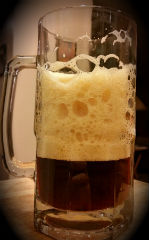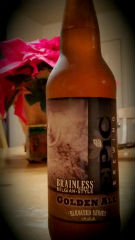
Written by Jeremy Hopkin
Reinheitsgebot ( a purity order) : Beer shall be made only with ingredients of water, malted barley, and hops.
This edict was put down by Albert IV of Bavaria in 1516 and is widely regarded as the world’s first purity law for foodstuffs. Although revised multiple times (and in all reality is now mostly a marketing ploy) – this rule is essentially still in effect in Germany. Most German brewers profess pride in this long tradition, with upturned noses at “beers” produced by any other method.
Although this tradition has allowed German brewers to produce consistently high quality beer (during a period of time where beer elsewhere was in decline), it is a very narrow definition of beer and also serves to hamper innovation. There is a small but vocal contingent of German brewers hoping to reverse this tradition and start a more creative brewing community – like the Americans!
The USDA (and America in general) allows for a much wider definition of beer – any beverage fermented by malted barley (or any other grain substitute), which contains at least one half of one percent alcohol content.
 This is a double edged sword. On one side – it allowed for the mass brewing of beer with low cost and poor quality fermentation products. In fact, many are shocked to know that the most widely consumed standard American lagers (Budweiser, Coors etc.) actually have a very low content of malted barley. Most of the fermentable sugars in these beers come from corn or corn syrup (mostly GMO corn) with a large contribution of rice and rice byproducts. On the flip side – this wider definition has allowed American microbrewers to pursue a wide range of beer styles and alternate brewing substrates.
This is a double edged sword. On one side – it allowed for the mass brewing of beer with low cost and poor quality fermentation products. In fact, many are shocked to know that the most widely consumed standard American lagers (Budweiser, Coors etc.) actually have a very low content of malted barley. Most of the fermentable sugars in these beers come from corn or corn syrup (mostly GMO corn) with a large contribution of rice and rice byproducts. On the flip side – this wider definition has allowed American microbrewers to pursue a wide range of beer styles and alternate brewing substrates.
What is beer for the rest of the world? Drinking fermented beverages is as old as civilization itself and its complexity often closely mirrors the progression of culture and religion within an evolving society. There is clear evidence of drinking fermented beverages as old as the cultivation of grains. Drinking fermented beverages likely even preceded agriculture itself, with some indication that early humans ingested fermented beverages made from all sorts of things – fruits, cactus and even tree sap!
There are many strong brewing traditions in other countries made from alternate fermentation products. For instance, in the high mountains of central Mexico, a low alcohol content beverage called pulque is made from the juice of a hollowed out agave cactus and spontaneously fermented by whatever wild yeast and bacteria are in the air. There is a centuries old tradition of pulque drinking in this region spanning back to the Mayans. Consumption was originally reserved for priests and royalty and was highly ritualized but eventually made its way into public consumption. Ingesting it is highly steeped in local folklore and is still served on wedding nights in this region with purported positive effects on libido, size of male genitalia and fertility. Ever seen a Viagra commercial? Same thing.
My family had the distinct pleasure to visit a pulqueria in the middle of nowhere Mexico and sample some of the local goods. The cactus farmer/pulque maker first took us on a boring tour of his cactus farm and then eventually took us into a pulque warehouse for some samples. It was a large wooden and corrugated tin warehouse full of open wooden vats full of liquid with a deep foam cap covered with copious numbers of flies on top. After shooing the flies and scraping the layer of foam from the top, he proceeded to pour us a mason jar full of this dubious beverage – cloudy, milky light green, and suspiciously full of “floaties.”
Oh well, cheers to the wife and – down the hatch! Even my son Kaleb had a taste without vomiting! (As a quick aside – it is important to remember that it is very rare to have dangerous pathogens in alcoholic beverages above about 3% ABV. The alcohol itself acts to sterilize most dangerous substances.) Because pulque is typically drunk during active fermentation, it was lightly carbonated and had a pungent and slightly sweet taste. It had aromas of cut grass and a bit of sour yogurt-like tartness during drinking. As we will learn in future articles, this typically indicates partial fermentation with lactobacillus. Despite its poor visual appeal – it was actually pretty good! I do unfortunately have to report that local folklore did not hold true. To my astonishment – drinking slimy alcoholic goo does not seem to increase your chances of getting lucky. My wife most defiantly did not come back from the trip leaden with child and my underwear size stayed the same. Damnation!
Although I have yet to try it, Russians drink a type of beer called kvass made from old bread, spent grains, and just about anything fermentable they can get their hands on. There is also an ancient Peruvian beer called Chicha that is made by chewing grains of corn, spitting it into a pot and fermenting the resulting liquid. Corn does not have the correct enzymes to break starches into sugars and the amylase in saliva is essential to fermentation. I have yet to try these, but it’s on the bucket list!
As you can see, my personal definition of beer is VERY wide. I consider any beverage made from local plants, grains, fruits or any other fermentable sugars to be loosely characterized as beer. While I can respect the Germans and their long traditions – to leave any of these wonderful fermenting traditions and products off the table when you sit down to make a brew is just plain silly. Your options for creating a unique and quaffable brew are literally endless!
 Conspicuously absent from the original reinheitsgebot and any of my above discussion is the main player – nay the kingpin, of all things alcohol. Meet Mr. Saccharomyces cervaciea – our good friend yeast! No adult beverages would be available without this ubiquitous and enigmatic organism. Its absence from the original reinheitsgebot was due to the fact that nobody knew how fermentation happened. It was felt to be a magical, mystical, and possibly even divinely inspired spontaneous process. Yeast was only added as an essential ingredient in the 19th century after its discovery as the fermenting agent by Louis Pasteur.
Conspicuously absent from the original reinheitsgebot and any of my above discussion is the main player – nay the kingpin, of all things alcohol. Meet Mr. Saccharomyces cervaciea – our good friend yeast! No adult beverages would be available without this ubiquitous and enigmatic organism. Its absence from the original reinheitsgebot was due to the fact that nobody knew how fermentation happened. It was felt to be a magical, mystical, and possibly even divinely inspired spontaneous process. Yeast was only added as an essential ingredient in the 19th century after its discovery as the fermenting agent by Louis Pasteur.
Saccharomyces runs a close third behind Homo sapien and Canis canis as the coolest organisms around. It clearly deserves its own column! But enough beer history and geekery for know. Lets drink! On our next column we will be going through the basics of tasting and judging a beer. My first pick is Epic brewery’s Brainless Belgian beer. Although not a super common style, it is a very approachable beer and is a good one to try for those folks who claim to not like beer. It is sold at the liquor store. Store it in your fridge at least over night. You will need a bottle of beer, a nice clean glass, and your very own pie hole for tasting. That’s it!
Cheers!
Doc Hop
 Jeremy Hopkin grew up in the heart of happy valley (Orem, UT). He received his undergraduate degree in zoology, got his M.D. degree from University of Utah, and did his residency in radiology at Dartmouth including a fellowship in neuroradiology. He is currently employed locally as a diagnostic radiologist and also treats varicose vein disease at Red Sands Vein and Laser Institute. He gives training and nutritional advice to athletes of all ages, shapes and sizes at Crossfit St. George and loves to help people attain their health goals. He is fascinated with science and is a tinkerer in all things fermentation. He’s been a home brewer for 7 years and is a beer lover for life!
Jeremy Hopkin grew up in the heart of happy valley (Orem, UT). He received his undergraduate degree in zoology, got his M.D. degree from University of Utah, and did his residency in radiology at Dartmouth including a fellowship in neuroradiology. He is currently employed locally as a diagnostic radiologist and also treats varicose vein disease at Red Sands Vein and Laser Institute. He gives training and nutritional advice to athletes of all ages, shapes and sizes at Crossfit St. George and loves to help people attain their health goals. He is fascinated with science and is a tinkerer in all things fermentation. He’s been a home brewer for 7 years and is a beer lover for life!



